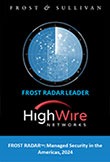4 Steps to Effective IT Security Marketing
If there is one advantage marketing IT security products, it is that you and your audience start from the shared perspective that taking steps to ensure the security of their networks and the data on them is important. As helpful as it is to have that common value, anyone who has tried to connect with potential (and sometimes current) customers knows that marketing IT security tools is still no easy task. Between a crowded field of competitors and the challenge of proving value, it can be hard to paint a clear picture of what you have to offer and how it can help end-users.
This is why when it comes to IT security marketing, it is best to strike a balance between practicing traditional marketing techniques and featuring the technical expertise that customers are looking for front-and-center. Because IT security is a continually growing market, it is more important than ever to set yourself apart from the competition. At the same time, your marketing strategy has to be flexible enough to bring in new clients while also responding to the changing needs of your current clients by bringing new, relevant solutions to their attention.
With an eye on these dynamics, here are 4 steps you can take to design and implement an effective IT security marketing strategy.
Determine your target market
The first step in effective marketing of any kind is to understand who your clients are and their individual business needs. In practice, this means focusing on a specific target market of security needs and conducting in-depth research to determine what security requirements potential clients in that market face, and what they expect from a security solution. Between the current threat landscape, the various regulatory frameworks that industries operate within, and the different resources available to large enterprises and SMEs, a one-size-fits-all approach to security is neither feasible nor profitable.
If you are already established in, or familiar with, an IT security market segment, it is still beneficial to conduct market research, as it can provide you with indicators of your current performance. If you’re not in the habit of doing this research on a regular basis, you might be surprised when expectations do not completely align with reality. Regardless of whether you’re new to a market or a veteran within it, market research will give you valuable information on which aspects of your business are performing best and which areas show a gap between what customers need from you and how well you represent solutions to those needs among your product lineup. The last thing you want is for your customers to want something that you already provide, and they don’t know about it.
At its best, solid market research can give a responsive business a leading edge by providing the right insight to anticipate clients’ needs. Beyond driving sales, this anticipatory posture also builds up trust with your clients, as they build an association of agility and attention to detail with your brand.
Build a strong online presence
In the IT security field, your website is often your potential and current customers’ first point of contact with you. That being said, you should do everything possible to treat it this way and make it the go-to resource that customers expect it to be. This starts with ensuring that you keep your website up-to-date with relevant and actionable information. If your customer support contact information or product offerings, or terms change, your website should be the first place to reflect that. From the standpoint of customer service excellence and brand trust, you can’t afford for a customer to look to your website for critical information only to not find it, whether on account of its absence or poor site organization.
This underscores the importance of clean and intuitive web design. Whether or not your business specializes in web design, customers assume you, as a “tech industry” player, have a handle on web development, so make sure your website is uncluttered, modern, easy to navigate, and free of typographical and rendering errors. Optimization for mobile browsing is a big part of this, so make sure your website will look good on any device. If you don’t have the in-house expertise to do this, it is incumbent on you to engage someone to design and, if necessary, manage your site for you.
A website is an important base to cover in an online marketing presence, but it is still just one part of a larger picture. If you aren’t doing so already, utilize social media to increase your online footprint. This requires more than registering accounts across major social networks and throwing up occasional posts. To create a seamless and comprehensive online strategy, your social media content needs to carefully match the tone and voice that you want your brand to project to your audience in particular, and the IT security field more broadly.
Once your online voice is solidified, you can begin using your social channels as a multipurpose conduit between you and your audience. A complete marketing operation capitalizes on the two-way dialogue that social media enables, so take advantage of the opportunity to use your social channels as another point of contact for customers, as a point of entry into industry conversation with a consistent flow of new content.
Offer solutions
In addition to your contact information, for sales and customer service, and a concise catalog of available services, your website should contain a trove of useful content where your customers can immediately act on and derive value. Whitepapers, blogs, videos, customer reviews, news, how-to guides, and infographics all fall under this umbrella, as they are informative and supplement your product offerings by presenting a constant stream of ideas for how your end-users can make the most of their relationship with you. As with your social media and online presence, the key here is to keep your brand voice consistent and to keep up a steady flow of new material to illustrate that you are engaged with the industry and with customer concerns.
The main objective you should pursue with website content is demonstrating your current, constantly growing expertise in the field and providing your existing clients with the resources they need to thoroughly address their business needs via your solutions. However, value-adding content also reinforces your marketing strategy by showing potential customers that you have your finger on the pulse of IT security trends and that you are willing to go the extra mile to meet your customers’ needs. If your company is able to consistently produce resources referenced across the industry, you draw in new clients with the prospect of greater value that comes with minting an ongoing, professional relationship with you. In essence, the hope is that your audience will be familiar enough with your work, and have a positive impression of it, that they will choose your brand when it comes time to buy.
Find your competitive advantage
Now that you have determined your target market, built up your online presence, and established a body of useful content on your website, it is time to identify and feature your competitive advantage. Cementing your competitive advantage is all about answering the question, “why should customers choose you?”
Most customers scan the market quickly and seize on the first strong, compelling argument that encapsulates a competitive advantage. This is because, especially in IT security, if a client is looking for a solution, it is usually due to the fact that they are in urgent need of a new game plan, either due to outsized cost or catastrophic failure of their current one.
It’s not enough to know you have the edge: If prospective clients don’t know it, it’s as good as if you didn’t have it in the first place. To make certain that you stand out in customers’ minds as embodying a competitive advantage, you have to be able to identify and articulate what makes you stand out, and why clients can’t afford to do without your services.
To zero in your competitive advantage, ask yourself what it is your company does that is head-and-shoulders above the rest? What services do you offer that others do not? What qualifications set you apart? The time you have to make this clear to a prospective customer is limited, as your customers have equally limited time (if not more so) to pivot to a new IT security strategy, so once you have locked onto your brand’s expression of its competitive advantage, make its presence prominent in everything you put out as part of your marketing initiative.









Leave a Reply